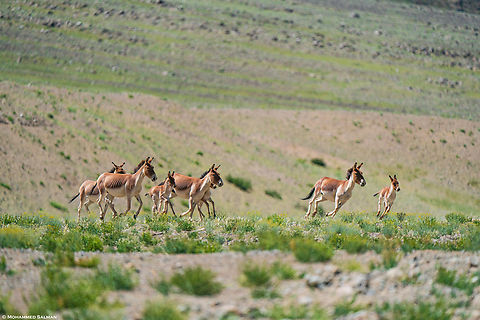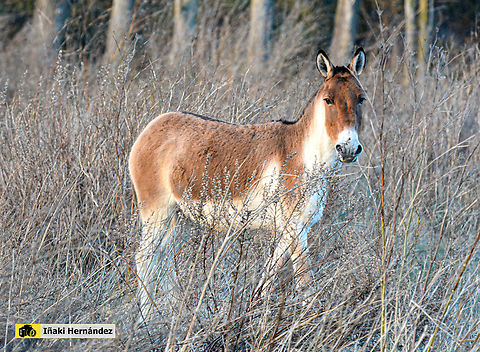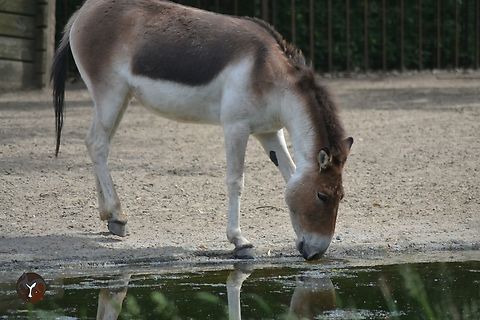
Appearance
The kiang is the largest of the wild asses, with an average height at the withers of 140 cm. They range from 132 to 142 cm high at the withers, with a body 182 to 214 cm long, and a tail of 32 to 45 cm. Kiangs have only slight sexual dimorphism, with the males weighing from 350 to 400 kg, while females weigh 250 to 300 kg. They have a large head, with a blunt muzzle and a convex nose. The mane is upright and relatively short. The coat is a rich chestnut colour, darker brown in winter and a sleek reddish brown in late summer, when the animal moults its woolly fur. The summer coat is 1.5 cm long and the winter coat is double that length. The legs, underparts, end of the muzzle, and the inside of the ears are all white. A broad, dark chocolate-coloured dorsal stripe extends from the mane to the end of the tail, which ends in a tuft of blackish brown hairs.
Distribution
Kiangs are found on the Tibetan Plateau, between the Himalayas in the south and the Kunlun Mountains in the north. This restricts them almost entirely to China, but numbers up to 2500 to 3000 are found across the borders in the Ladakh and Sikkim regions of India, and smaller numbers along the northern frontier of Nepal.Three subspecies of kiangs are currently recognised:
⤷ "E. k. kiang" — western kiang
⤷ "E. k. holdereri" — eastern kiang
⤷ "E. k. polyodon" — southern kiang
The eastern kiang is the largest subspecies; the southern kiang is the smallest. The western kiang is slightly smaller than the eastern and also has a darker coat. However, no genetic information confirms the validity of the three subspecies, which may simply represent a cline, with gradual variation between the three forms.

Behavior
Like all equids, kiangs are herbivores, feeding on grasses and sedges, especially "Stipa", but also including other local plants such as bog sedges, true sedges, and meadow grasses. When little grass is available, such as during winter or in the more arid margins of their native habitat, they have been observed eating shrubs, herbs, and even "Oxytropis" roots, dug from the ground. Although they do sometimes drink from waterholes, such sources of water are rare on the Tibetan Plateau, and they likely obtain most of their water from the plants they eat, or possibly from snow in winter.Their only real predator other than humans is the Himalayan wolf. Kiangs defend themselves by forming a circle, and with heads down, kick out violently. As a result, wolves usually attack single animals that have strayed from the group. Kiangs sometimes gather together in large herds, which may number several hundred individuals. However, these herds are not permanent groupings, but temporary aggregations, consisting either of young males only, or of mothers and their foals. Older males are typically solitary, defending a territory of about 0.5 to 5 km2 from rivals, and dominating any local groups of females. Territorial males sometimes become aggressive towards intruders, kicking and biting at them, but more commonly chase them away after a threat display that involves flattening the ears and braying.
Habitat
Kiangs inhabit alpine meadows and steppe country between 2,700 and 5,300 m elevation. They prefer relatively flat plateaus, wide valleys, and low hills, dominated by grasses, sedges, and smaller amounts of other low-lying vegetation. This open terrain, in addition to supplying them with suitable forage absent in the more arid regions of central Asia, may make it easier for them to detect, and flee from, predators.Reproduction
Kiangs mate between late July and late August, when older males tend reproductive females by trotting around them, and then chasing them prior to mating. The length of gestation has been variously reported as seven to 12 months, and results in the birth of a single foal. Females are able to breed again almost immediately after birth, although births every other year are more common. Foals weigh up to 35 kg at birth, and are able to walk within a few hours. The age of sexual maturity is unknown, although probably around three or four years, as it is in the closely related onager. Kiang live for up to 20 years in the wild.References:
Some text fragments are auto parsed from Wikipedia.